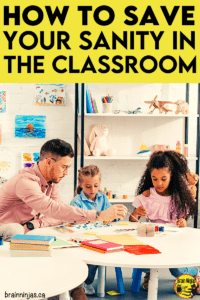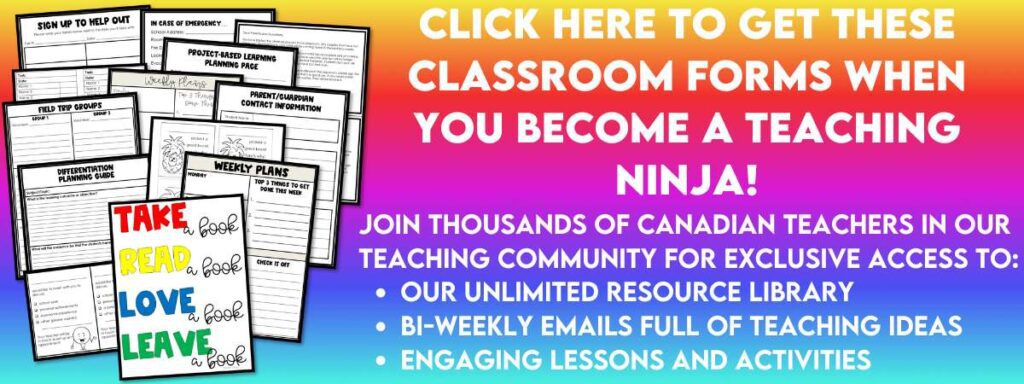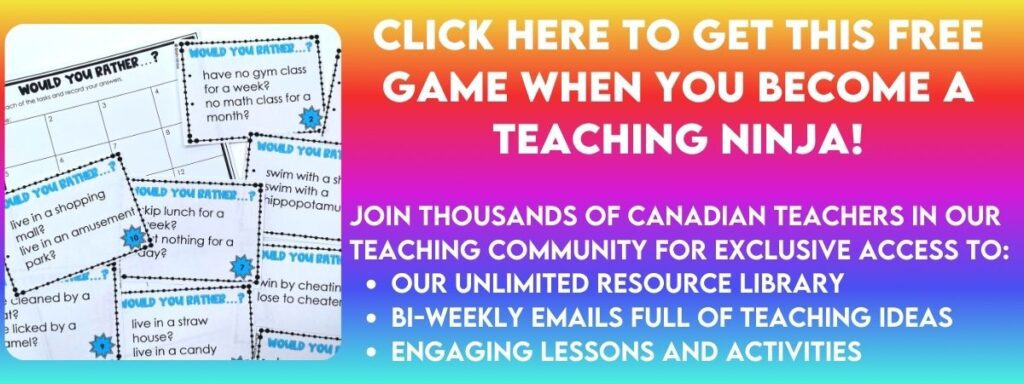
Each year, we work hard to teach students some basic courtesies to make everyone happier and keep students responsible for their learning space. These are the basic things we teach repeatedly during the first month of school to our upper elementary students. Save your sanity by giving them a try.
We also want to stress that just because this is how we do things doesn’t mean these procedures will work ‘as is’ in your classroom. Feel free to solve the issues in your own way.
By teaching these courtesies, we reduce our own frustrations and the frustrations of students because they already know how to handle these situations.
How to Interrupt
The short answer; don’t. We teach students that when two people are already talking, they shouldn’t interrupt. However, if they need to speak to one of the people, we show our students the correct way to interrupt politely. We practice this through role-playing with each other.
More importantly, we teach our students that before they come to ask one of the adults in the classroom, they should try asking a classmate. This is simple math. There are twenty-seven other people available to ask rather than waiting for the adult (who is not always going to be available).
We include reasons for interrupting or not interrupting. If there are life and death medical issues, students do not need to wait. They are encouraged to get help immediately.
We set students up for success by having tissues, bandages, brooms, paper towels and other supplies they would need to handle a simpler situation themselves.
How and When to Sharpen a Pencil

We have an electric pencil sharpener, which is noisy but efficient. There is a very clear sign on the sharpener to not use coloured pencils in it (they always get jammed. We have a Stadler handheld sharpener available for students to use for coloured pencils.
If a student needs to sharpen, they are free to do so by going to stand at the pencil sharpener. If we are giving instructions or speaking to the class, they wait until one of us makes eye contact and nods, signalling to start sharpening. Otherwise, they wait. Students have learned that waiting to sharpen means the lesson isn’t disrupted and it doesn’t stop other students from learning.
If it’s independent work time, they are free to sharpen as needed. Students know they should use the sharpener alone, especially if they are there to work.
The other option available at any time is to use their hand sharpener at their desk, but we only allow sharpeners that hold the shavings. Let the lesson continue.
We talk about not sharpening pencils to death and there is a little poster with a length requirement for pencils to go into the sharpener. The poster was created by a student whose pencil died in the sharpener and we had to send it away for maintenance.
How to Clean Up the Floor

Speaking of shavings, they make a mess. So do water bottles.
We don’t have carpet, but that doesn’t stop the mess.
In our classroom, we have several small handheld brooms and dustpans from a dollar store and students are allowed and encouraged to use them when they make a mess. We also have a bag of rags (old tea towels and face cloths) for wet spills (instead of paper towels). We have two bags – wet & dry, where kids put and get the rags.
Students in our room are responsible for the floors all day, every day. We even keep a box of wet wipes to use just in case of stickier messes.
Each and every day, our students tidy up the floors. This included picking up belongings and returning them to the owners (or lost and found). We do this to take ownership of the classroom and to help out our school custodians (who can then wash the floor without having to pick up everything).
If you’re teaching art, we have more cleaning routines that you can read about: Are You Avoiding Teaching Art? How to Fix That.
How and When to Use the Washroom or Get a Drink

Students are free to use the bathroom or drinking fountain during independent work time by writing their names on the board. We allow one student to leave the room at one time. Part of this is because our school restroom facilities only have two toilets each (so we leave room for other classes). They erase their name when they return.
No one is allowed to leave during instruction or whole group activities like community circles. We also allow water bottles that lock shut in our room if they are filled with water only. This is to prevent sticky spills but still allow students to hydrate.
Our only other bathroom rule is that students need to have shoes on to go use the facilities. We point out that the floor of the washroom could be wet with water, soap or something questionable.
Sometimes, students just need a break from the classroom. So, we don’t record bathroom or drink visits. We do take notice if the same student is always in the bathroom and will ask the student privately if there’s a problem. Sometimes, there is a problem and then we help by informing parents.
We also have an emergency clause. If a student thinks they cannot wait to use the washroom or if they are sick, they are allowed to break the rules.
Respecting Extroverts and Introverts
Early in the year, we talk a lot about our learning preferences and how much noise is too much. We explicitly teach students to work quietly or how to work out loud without being too loud.
It takes a lot of practice and awareness for students to learn how they learn. For most independent work times, we start with “introvert time,” 15-20 minutes of quiet processing and work. Then, we start to allow “extrovert time” so students can talk more freely.
The times alternate depending on the activity and we continue to teach students that both types of work time are important to learning, but they both have a purpose.
It is so important to honour the quiet time introverts crave. Sometimes, we can do this by allowing students to work in a more quiet area of the classroom. Sometimes, we have a set amount of quiet time during the day.
We also have red cups. These are just plain old red cups. When a student places one on their desk, they are saying to everyone else that they are not available to be asked questions or visit with anyone. Other students in the class know that this red cup signals the person would like to be left to work quietly. Use any item that several students can use at the same time as long as you and your students are in agreement.
To get to know our extroverts and introverts, we do a lot of small group discussion activities. This Would You Rather? game is available in our Resource Library, or we can send you a copy when you sign up for our email list.
How to Use the Lost and Found

On one of the first days we have each year is “write your name on everything” day. This saves a lot of time because when students are tidying, they return misplaced items directly to students.
We also have a bin where misplaced items can be placed until their owners find them. This lost and found bin is also a “free to use” place where extra pencils, scissors and other items are available.
Students are encouraged to look in the bin for their own items, but if a student needs something, they are welcome to use items from the bin (even if they have someone’s name on them). After they finish, they are asked to return the item.
We stock up the bin with a few pairs of scissors and pencil crayons. The bin keeps itself stocked with items found in the classroom all year.
If a student finds a special item that doesn’t look like a typical school item or something that the owner would miss, we have a rule to place these things on the chair at my desk. Students who lose these types of items will always check with me first. The majority of students are honest when they find or lose something, so this isn’t usually a problem.
How to Get Help
We have different ways students ask for help depending on the activity.
Emergency Help (like medical emergencies)
Students are taught to use the word emergency ONLY for a real emergency. We’ve had students with severe allergies, epilepsy and diabetes. We educate students about what to do for medical situations so they can be prepared.
How do you handle confidentiality? We ask parent permission and quite often, the affected student does the teaching to the class. Due to the seriousness, parents are usually good with the plan.
Students are taught how to dial out of the school with the classroom phone (because you have to listen for a dial tone and then dial a number, wait for a dial tone and then dial the number), but they are also told where to go in the school to get adult help in case one of the adults in the room cannot help.
Use a Leader or Liasion
When we are working with a small group at the table, we are not available to help. We assign liaisons to help out their fellow classmates. You can read more about this in our post How to Make Them Listen Without Yelling.
Use a Running List for Conferencing
When we are conferencing with students individually, we sit at the table and invite students to come work with us. They “sign up” by writing their name on the board in a list. When we finish with a student, we call out the next name and the student we’ve just met with, they erase their name. Students who are waiting work on other things while they wait instead of standing in a line.
When we get close to running out of time, we’ll instruct a student to draw a double line under the list. Students can still write their names. We take a photo of the list and the next time we conference, we start with those names.
If you’d rather use a paper checklist with your student names, an editable name checklist can be found in our Resource Library, along with many other general classroom forms to help you organize your classroom. Or we can send it directly to your inbox when you sign up for our email list.

Use Your Email
We teach our students how to send an email using their school email to us (the teachers). We explain that this is a way to reach out to us without having to speak face to face. With this, we teach all students to keep their passwords protected and to use their email responsibly.
We’ve had students ask for help with homework, family situations and even an embarrassing health problem. Students who have difficulty talking about issues face to face can sometimes find this method much easier.
These procedures seem so simple, but the amount of time they save in the long run is worth it. Spending the first month repeatedly teaching, practicing and monitoring these classroom procedures will make your year run smoothly. If you’re struggling with your classroom management, you might want to read Why Your Classroom Management Isn’t Working and How to Fix It.
What other courtesies do you include? Add them to our comments below because we’d love to add them to our list.








I love introvert and extrovert time! Have you read Quiet bu Susan Cain? She describes the need for exactly the system you describe!
Oh wow! Add that to our reading list! Thanks!